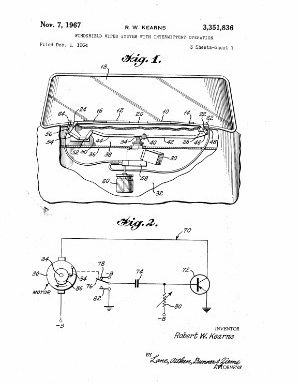LENS Innovate
Blink of an Eye
The Accidental Birth of a Standard Auto Feature
 IMAGE: UNITED STATES PATENT AND TRADEMARK OFFICE
IMAGE: UNITED STATES PATENT AND TRADEMARK OFFICE
Robert Kearns, PhD (CIT '64), attributed his invention of the intermittent windshield wiper to a wedding night accident: As he was opening a champagne bottle in his hotel room, the cork flew off and hit him in the eye, leaving him with impaired vision. The injury eventually turned a frustrated drive on a rainy day in 1962 into innovation.
"Why can't a wiper work more like an eyelid?" the longtime garage tinkerer and Case Western Reserve alumnus thought, as he later recounted to The New Yorker. At the time, wipers had two speeds, slow and fast, but the motion was constant. "Why can't it blink?"
 IMAGE: UNITED STATES PATENT AND TRADEMARK OFFICE
IMAGE: UNITED STATES PATENT AND TRADEMARK OFFICE
Kearns' invention may seem ordinary now—a nearly universal standard on today's vehicles—but it was revolutionary at the time. Engineers at Ford Motor Co. were so amazed when Kearns first showed them the design in action, The Washington Post later reported, that they made him leave the room. They were convinced Kearns was activating the wipers remotely with a button in his pocket.
But Kearns' invention wouldn't stay his for long. Car companies—Ford included—began rolling out the wipers on their new cars without crediting him. He sued the carmakers and won more than $20 million in a decades-long litigation battle that eventually reached the Supreme Court and inspired the 2008 Greg Kinnear-led biopic, Flash of Genius. "I don't think the goal was the magnitude of the money," Kearns, who died in 2005, once told reporters. "My role was to defend the patent system."





